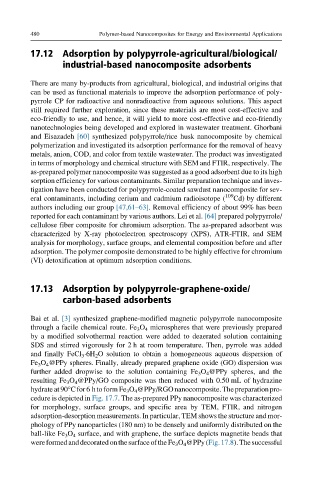Page 527 - Polymer-based Nanocomposites for Energy and Environmental Applications
P. 527
480 Polymer-based Nanocomposites for Energy and Environmental Applications
17.12 Adsorption by polypyrrole-agricultural/biological/
industrial-based nanocomposite adsorbents
There are many by-products from agricultural, biological, and industrial origins that
can be used as functional materials to improve the adsorption performance of poly-
pyrrole CP for radioactive and nonradioactive from aqueous solutions. This aspect
still required further exploration, since these materials are most cost-effective and
eco-friendly to use, and hence, it will yield to more cost-effective and eco-friendly
nanotechnologies being developed and explored in wastewater treatment. Ghorbani
and Eisazadeh [60] synthesized polypyrrole/rice husk nanocomposite by chemical
polymerization and investigated its adsorption performance for the removal of heavy
metals, anion, COD, and color from textile wastewater. The product was investigated
in terms of morphology and chemical structure with SEM and FTIR, respectively. The
as-prepared polymer nanocomposite was suggested as a good adsorbent due to its high
sorption efficiency for various contaminants. Similar preparation technique and inves-
tigation have been conducted for polypyrrole-coated sawdust nanocomposite for sev-
eral contaminants, including cerium and cadmium radioisotope ( 109 Cd) by different
authors including our group [47,61–63]. Removal efficiency of about 99% has been
reported for each contaminant by various authors. Lei et al. [64] prepared polypyrrole/
cellulose fiber composite for chromium adsorption. The as-prepared adsorbent was
characterized by X-ray photoelectron spectroscopy (XPS), ATR-FTIR, and SEM
analysis for morphology, surface groups, and elemental composition before and after
adsorption. The polymer composite demonstrated to be highly effective for chromium
(VI) detoxification at optimum adsorption conditions.
17.13 Adsorption by polypyrrole-graphene-oxide/
carbon-based adsorbents
Bai et al. [3] synthesized graphene-modified magnetic polypyrrole nanocomposite
through a facile chemical route. Fe 3 O 4 microspheres that were previously prepared
by a modified solvothermal reaction were added to deaerated solution containing
SDS and stirred vigorously for 2 h at room temperature. Then, pyrrole was added
and finally FeCl 3 6H 2 O solution to obtain a homogeneous aqueous dispersion of
Fe 3 O 4 @PPy spheres. Finally, already prepared graphene oxide (GO) dispersion was
further added dropwise to the solution containing Fe 3 O 4 @PPy spheres, and the
resulting Fe 3 O 4 @PPy/GO composite was then reduced with 0.50 mL of hydrazine
hydrateat90°Cfor6 htoform Fe 3 O 4 @PPy/RGOnanocomposite.Thepreparationpro-
cedure is depicted in Fig. 17.7. The as-prepared PPy nanocomposite was characterized
for morphology, surface groups, and specific area by TEM, FTIR, and nitrogen
adsorption-desorption measurements. In particular, TEM shows the structure and mor-
phology of PPy nanoparticles (180 nm) to be densely and uniformly distributed on the
ball-like Fe 3 O 4 surface, and with graphene, the surface depicts magnetite beads that
wereformedanddecoratedonthesurfaceoftheFe 3 O 4 @PPy(Fig.17.8).Thesuccessful

